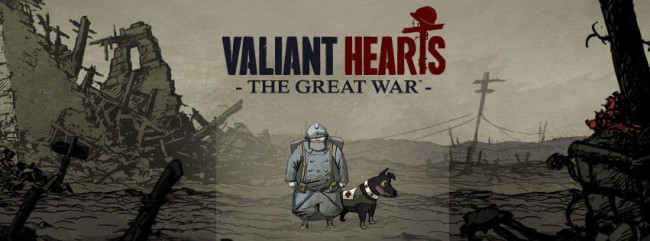
I honestly couldn’t tell you how many Nazis I’ve taken down via World War II based shooters over the last two decades. Thousands upon thousands, I’m more than certain of it. And yet, with so many virtual casualties at my behest, I never really stopped to contemplate the human suffering of the war I was fighting, while playing one of those games. I understand that wasn’t their intended purpose, but why shouldn’t it be sometimes? When I heard about Valiant Hearts, it dawned on me that I hadn’t played a game set during The Great War before. Why was that? I asked myself. Perhaps Nazi’s are an easy target to parody without causing too much offence, or maybe the weapons and technology of the era didn’t make for good gameplay? Whatever the reason, I wanted to play and find out for myself.

Valiant Hearts is a game set during World War I, or “The Great War” as it’s more famously known as. What’s special about this particular tale is that it’s loosely based on real letters from that era; although, by loosely, I mean very. The story is centered around Emile, a mature-aged French farmer who is conscripted to fight for France when the war with Germany broke out. However, the situation is further complicated as his son-in-law, Karl, is German, and is deported from France to fight on the opposing side; leaving his wife, Marie (Emile’s daughter), and their new-born son all alone.
I think, given the recent E3 trailer, a lot of people might go into Valiant Hearts expecting an emotionally powerful story from beginning to end. However, this is still a fictional tale, and for a large proportion of the narrative, you will be pursuing the moustachioed Baron Von Dorf; an almost comical German commander, and the game’s main antagonist. For the most part, these segments are entertaining, but they’re also stark in contrast to the gritty heart-felt character story at the core of the experience. As such, the game can feel a little at odds with itself, but fortunately, this does not impede the impact of the events taking place, and a conclusion that will have players sitting on the edge of their seats.
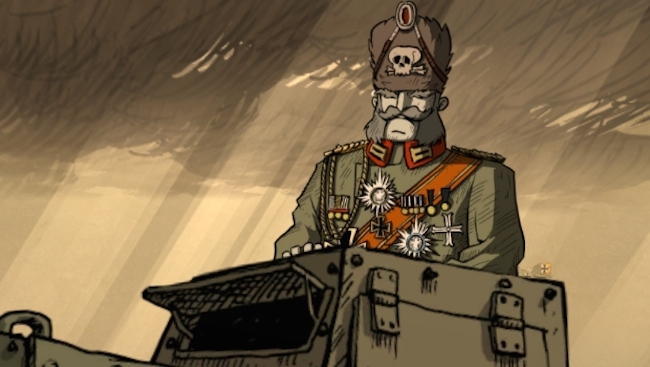
The greatest thing about this game is less about the fictional story, and rather its portrayal of historical events that young people might not be aware of. We commemorate ANZAC Day in Australia each year, but how much does our generation really know about The Great War? In Valiant Hearts, there are more than 100 collectable items, with each providing a small snippet of information about that era. This also works in conjunction with photographs and historical accounts of the real events that took place in each area of the game you visit, as well as the battles being portrayed.
Valiant Hearts explores a perspective of war that’s not been seen in a game before. Baron Von Dorf is, in my opinion, an unnecessary comedic relief. However, with that being said, overall, both sides are portrayed with due respect; demonstrating the humanity of those individuals who sacrificed their lives for their country. It also provides us with the opportunity to see what happened inbetween the shooting, and how people of opposing sides would even help each other given the right circumstances. This wasn’t a tale of good versus evil, but of human beings stuck in a conflict neither side could escape. It’s honestly given me a lot to contemplate, and I don’t think I could ask for more than that.
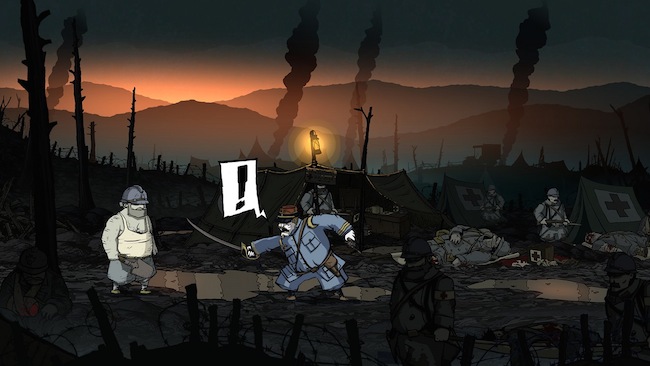
It’s clear a lot of thought went into the design, given the sensitivity of the subject, as well as choosing to develop the game as a puzzle platformer. What’s especially unique, though, is that the game is played from the perspective of four very different people; serving completely contrasting roles in the war. The great thing about this is that the objectives are mostly different based on which character you’re playing. This isn’t all about shooting or killing people; in fact, Anna, one of the protagonists, serves the exact opposite purpose; with goals based on helping people and first aid.
While there are regular platforming segments in the game, the experience is primarily focused on solving puzzles; albeit, not the most difficult ones. The problem, however, is that many of the puzzles are focused around item collection, so, despite the variety of each character’s objectives, it can sometimes start to feel a little repetitive; especially in the earlier chapters of the game. As the game progresses, though, there is an increased diversity of unique gameplay segments which help to break things up, and keep the flow of the game steady. Some of these ideas included musical car chases, a well implemented stealth section, and just enough combat to satisfy action fans.
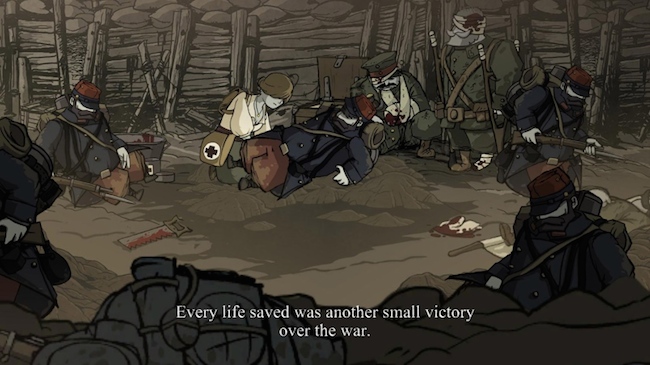
Valiant Hearts is a well built game, which, in my opinion, exceeds at delivering entertaining gameplay within a genre that can, at times, struggle to develop strong mechanics outside of those which serve the narrative. Whether you were digging in the trenches as Emile, driving a tank into combat as Freddie, attempting to escape a POW camp as Karl, or bandaging a wounded soldier as Anna, the game always played very well. It’s worth noting the lack of consequence for failure, but I guess this makes sense, as in conjunction with a help system, it’s evident the designers wanted to ensure that players of any skill levels could reach the conclusion. It’s not a hard game, but it still feels very rewarding.
There are still a few ideas which don’t quite come together, despite the overall diversity; such as the quick time events used for many of Anna’s objectives. That said, I can still appreciate what the developers were trying to achieve with this approach. More than any other mechanics, though, I think the dogs play one of the most crucial roles of the entire game; acting as the primary companion for most of the characters throughout. The dogs are not directly playable, but you can issue commands such as having them crawl through tunnels, distract guards, pickup items, and even pull levers. By the end of the game, for me, there was a tight bond that had developed due to the consistent co-operation.
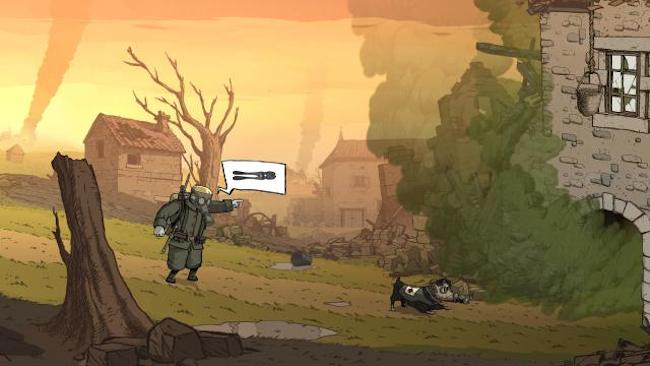
I absolutely adore the UbiArt Framework; everything created with it so far has simply been breathtaking to look at. With that in mind, though, I was very interested to see how it could convey the darker moments from The Great War, given Ubisoft Montpellier’s tendency to cartoonify the artwork of their games. Valiant Hearts employs a very unique style that’s far enough from ultra-realism to avoid raising the concern of the non-gaming public, but with enough basis in reality to portray the grit and horror of war. In its brightest moments, it feels as if you’re playing a french cartoon; which is a lot of fun. However, what impressed me was how powerful the visuals were in the final chapter of the game; demonstrating the dreadful conditions of the trenches without relying on shock tactics. It was incredibly well done.
The soundtrack is something else altogether, though. Which, of course, is a very subjective claim, but I certainly thought they absolutely nailed it. From the moment you reach the starting screen, you are met with a beautifully inspired piano score that perfectly sets the tone for the rest of the game. I think, in part, the soundtrack is emphasised by the lack of direct dialogue throughout. There’s a narrator who will detail the main plot inbetween each scenario, and this works well, in my opinion, but during gameplay, the characters mostly communicate with visual bubbles, or with short “simmish” sounding dialogue that’s only just audible enough to get the main point across – “ahthankyamate!”
 A genuinely moving portrayal of The Great War
A genuinely moving portrayal of The Great War
 Variety in objectives between characters
Variety in objectives between characters
 Explores interesting and unique gameplay ideas
Explores interesting and unique gameplay ideas
 UbiArt Framework captures the tone perfectly
UbiArt Framework captures the tone perfectly
 Soundtrack is inspired from beginning to end
Soundtrack is inspired from beginning to end
 Baron Von Dorf doesn’t suit the narrative
Baron Von Dorf doesn’t suit the narrative
 Puzzle design can feel repetitive at times
Puzzle design can feel repetitive at times
Valiant Hearts: The Great War is an inspired experience that explores a side of war that’s not often seen in video games. The characters are all very well written; with each providing a unique perspective that is also reflected in the objectives. Repetitiveness can become a problem at times, but fortunately, short creative bursts help to ensure things keep moving forward. It’s actually quite awe-inspiring how well the UbiArt Framework portrays the heart of the time period, as well as the brutality of the war. In my opinion, the game didn’t need a villain to drive the player’s motive, but in saying that, the moustachioed menace didn’t take away from its emotionally powerful conclusion. Despite any shortcomings, I’ve gained an incredible amount of knowledge from my time with Valiant Hearts. It’s left me with a lot to contemplate, and with a whole different perspective on war. For this reason, I would recommend this game to anyone.











